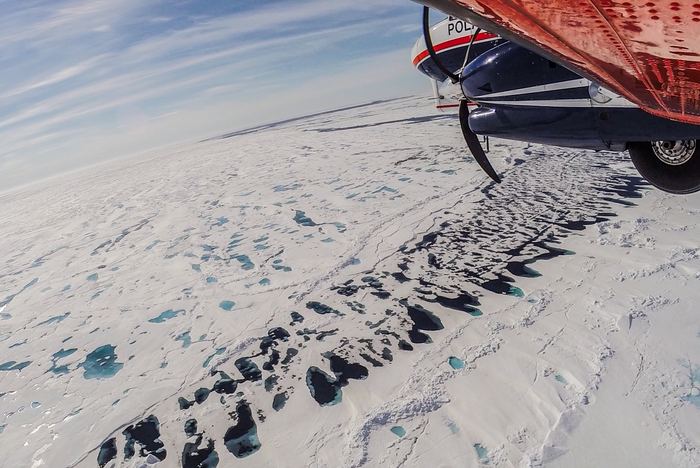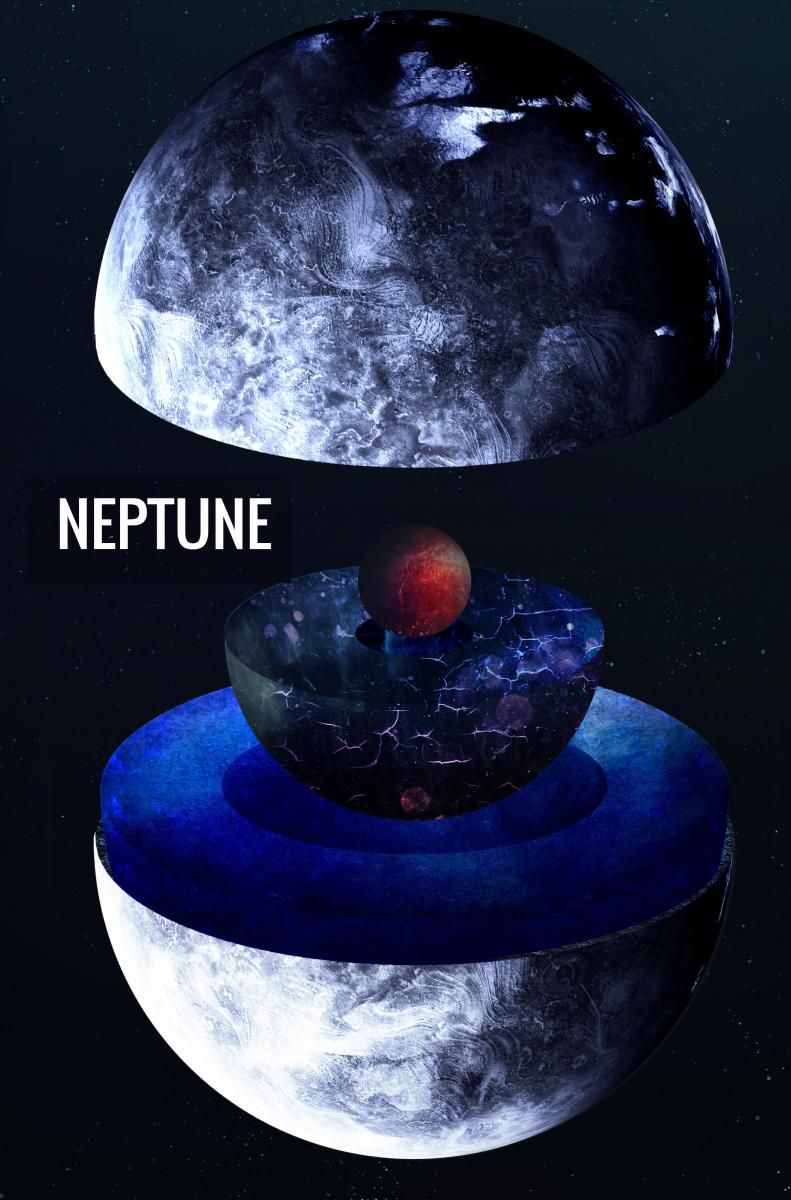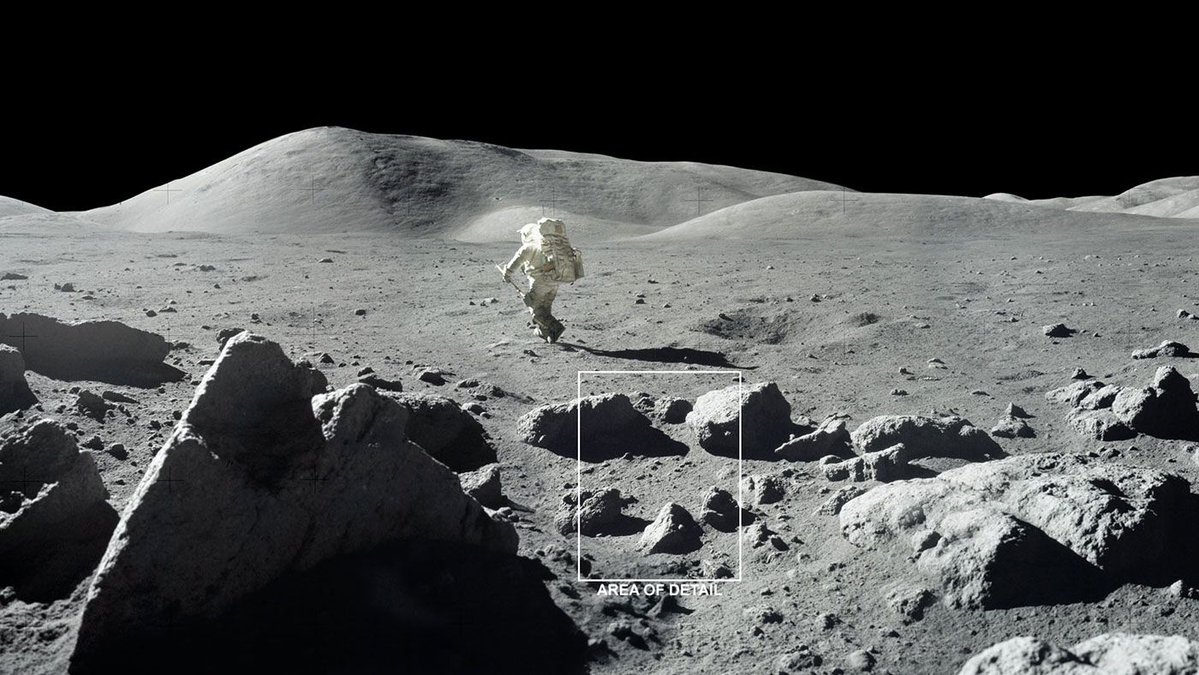Artificial intelligence can do more than paint planets as bowls of soup. It’s now helping researchers acquire better climate change data by teaching Earth observation satellites how to measure ice thickness in the Arctic year-round.
Continue reading “Satellites can now Measure the Thickness of Ice Sheets all Year Long”Water Worlds Could Have Plumes of Nutrients Carried up From Down Below
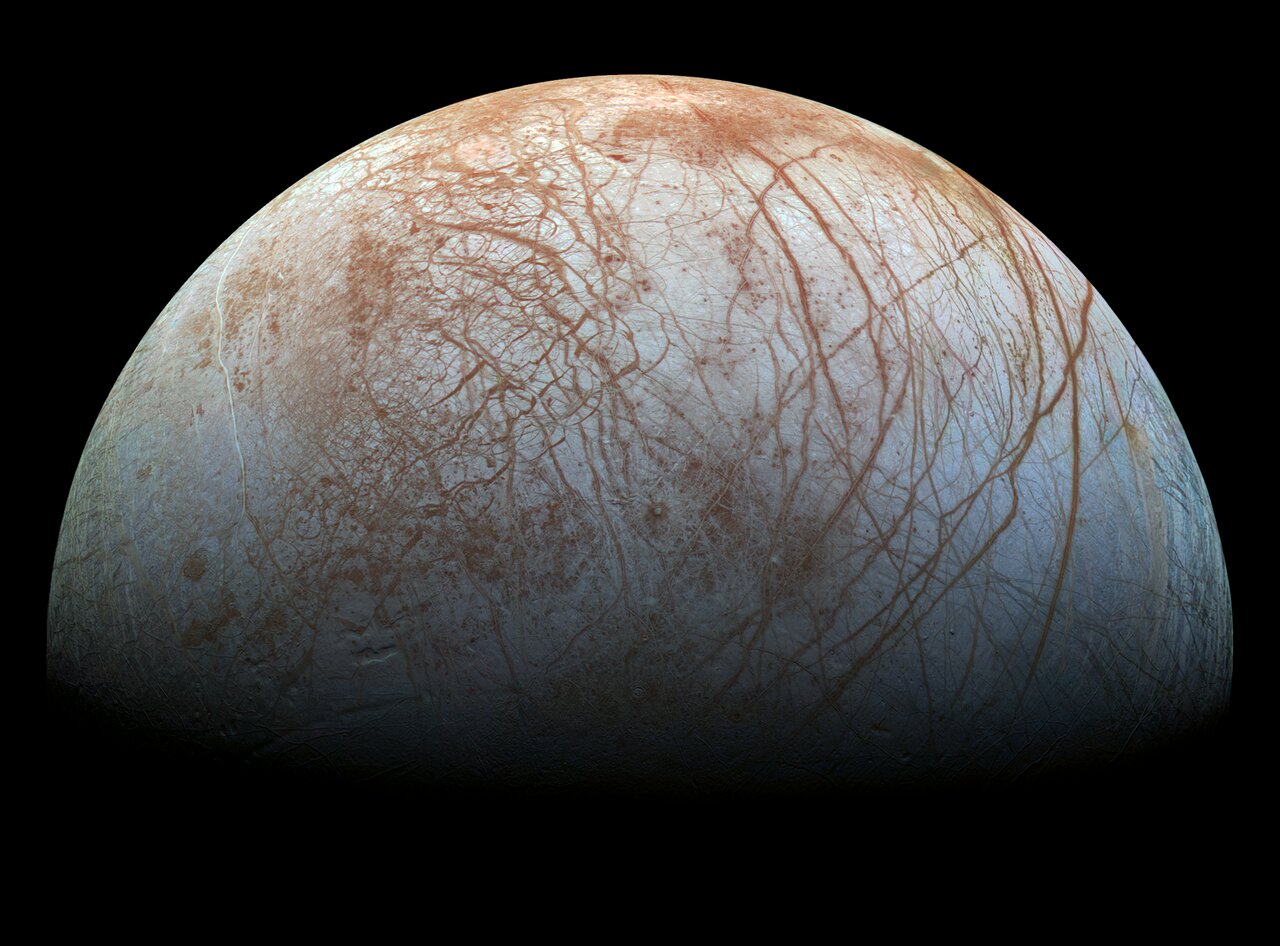
Earth’s oceans are one huge, uniform electrolyte solution. They contain salt (sodium chloride) and other nutrients like magnesium, sulphate, and calcium. We can’t survive without electrolytes, and life on Earth might look very different without the oceans’ electrolyte content. It might even be non-existent.
On Earth, electrolytes are released into the oceans from rock by different processes like volcanism and hydrothermal activity.
Are these life-enabling nutrients available on water worlds?
Continue reading “Water Worlds Could Have Plumes of Nutrients Carried up From Down Below”Why do Uranus and Neptune Have Magnetic Fields? Hot ice
The outer “ice giant” planets, Neptune and Uranus, have plenty of mysteries. One of the biggest is where exactly they got their magnetic fields. They are strong at that, with Neptune’s being twenty-seven times more powerful than Earth’s, while Uranus’ varies between ? and four times Earth’s strength. Chaos rules in these electromagnetic environments, making them exceptionally hard to both understand and model. Now a team of researchers led by Dr. Vitali Prakpenka of the University of Chicago thinks they might have found the underlying cause of both the field’s strength and its randomness – “hot ice.”
Continue reading “Why do Uranus and Neptune Have Magnetic Fields? Hot ice”Shadows on the Moon Could be Hiding Water, Even in the Daytime
Shadows have been known throughout history to be excellent hiding places. They may even be hiding unexpected things off the Earth as well. According to a new NASA study, there might be water that moves from shadow to shadow on the moon – even in daylight.
Continue reading “Shadows on the Moon Could be Hiding Water, Even in the Daytime”Beautiful Image of Ice at Mars’ Northern Polar Cap
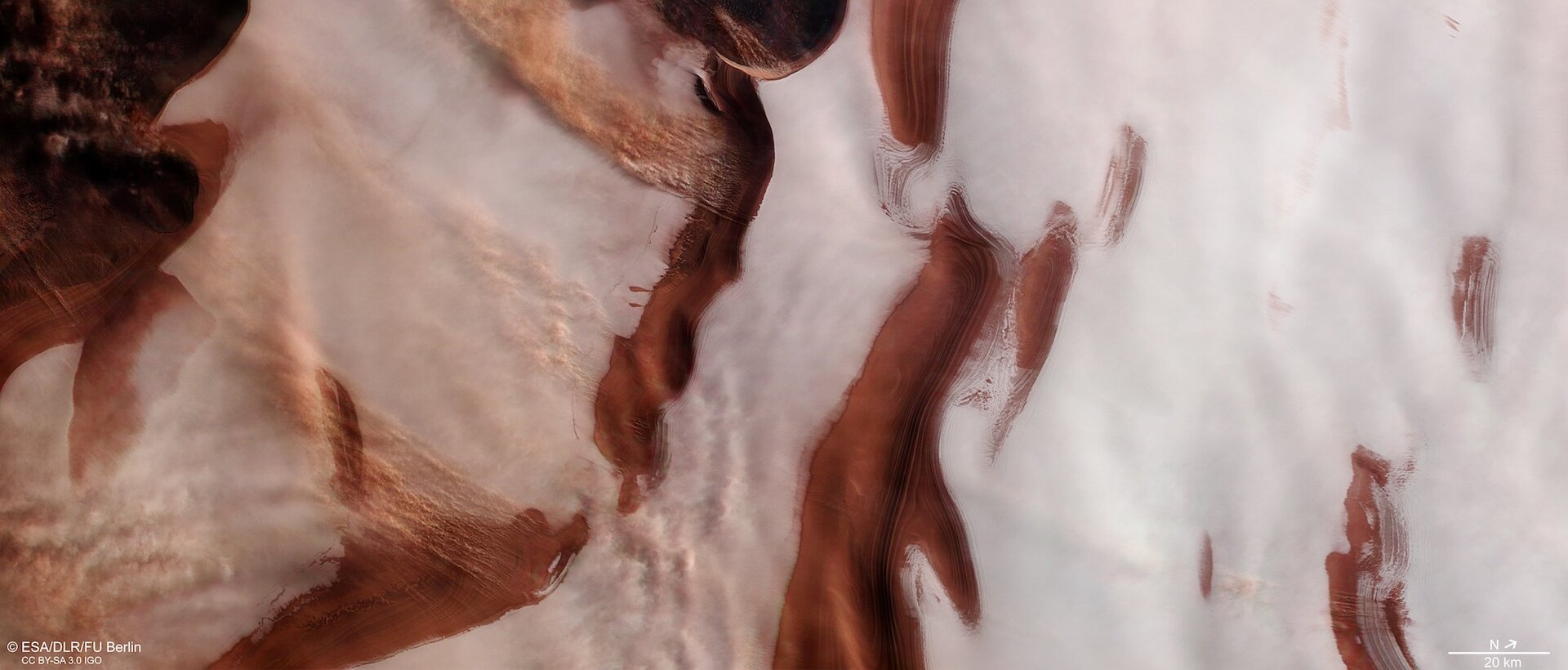
A new image from the ESA’s Mars Express spacecraft shows how beautiful, and desolate, Mars can appear. It also highlights some of the natural process that shape the planet’s surface. The image is of the northern polar region, and it features bright patches of ice, deep dark troughs, and evidence of storms and strong winds.
Continue reading “Beautiful Image of Ice at Mars’ Northern Polar Cap”Icy Hot: Europa’s Frozen Crust Could Be Warmer Than We Thought
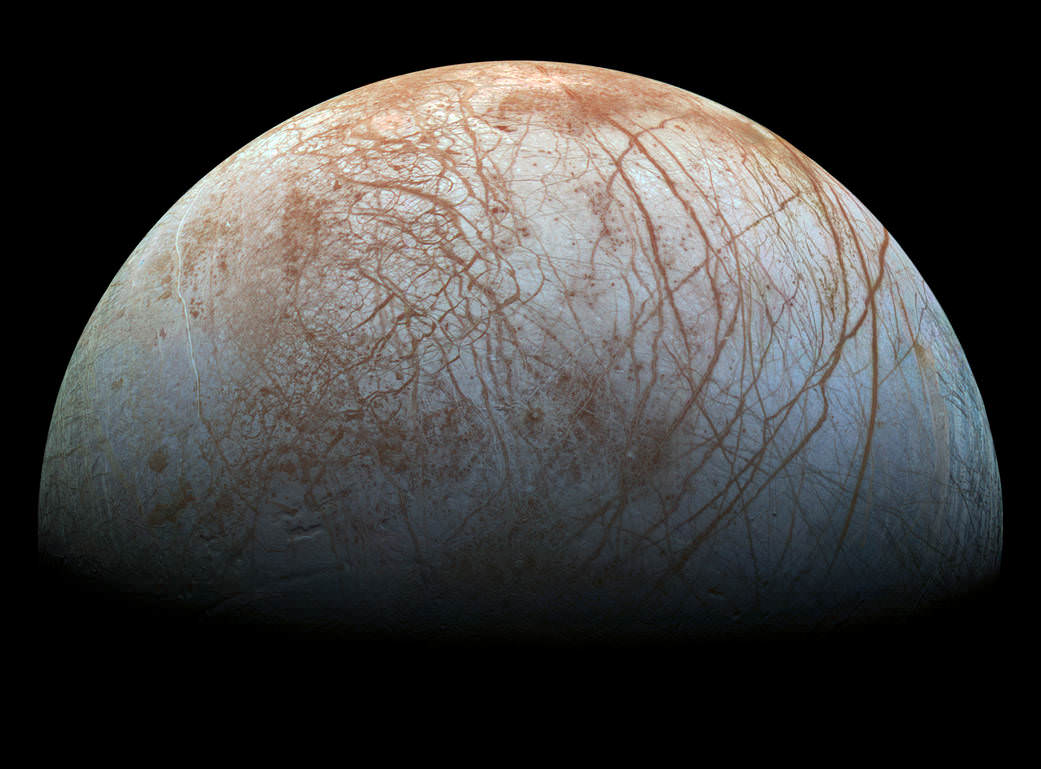
All the worlds may be ours except Europa but that only makes the ice-covered moon of Jupiter all the more intriguing. Beneath Europa’s thin crust of ice lies a tantalizing global ocean of liquid water somewhere in the neighborhood of 100 kilometers deep—which adds up to more liquid water than is on the entire surface of the Earth. Liquid water plus a heat source(s) to keep it liquid plus the organic compounds necessary for life and…well, you know where the thought process naturally goes from there.
And now it turns out Europa may have even more of a heat source than we thought. Yes, a big component of Europa’s water-liquefying warmth comes from tidal stresses enacted by the massive gravity of Jupiter as well as from the other large Galilean moons. But exactly how much heat is created within the moon’s icy crust as it flexes has so far only been loosely estimated. Now, researchers from Brown University in Providence, RI and Columbia University in New York City have modeled how friction creates heat within ice under stress, and the results were surprising.
Continue reading “Icy Hot: Europa’s Frozen Crust Could Be Warmer Than We Thought”
How Do We Terraform The Moon?

Welcome back to our ongoing series, “The Definitive Guide To Terraforming”! We continue with a look at the Moon, discussing how it could one day be made suitable for human habitation.
Ever since the beginning of the Space Age, scientists and futurists have explored the idea of transforming other worlds to meet human needs. Known as terraforming, this process calls for the use of environmental engineering techniques to alter a planet or moon’s temperature, atmosphere, topography or ecology (or all of the above) in order to make it more “Earth-like”. As Earth’s closest celestial body, the Moon has long been considered a potential site.
All told, colonizing and/or terraforming the Moon would be comparatively easy compared to other bodies. Due to its proximity, the time it would take to transport people and equipment to and from the surface would be significantly reduced, as would the costs of doing so. In addition, it’s proximity means that extracted resources and products manufactured on the Moon could be shuttled to Earth in much less time, and a tourist industry would also be feasible.
Continue reading “How Do We Terraform The Moon?”Does Antarctica Have A Hidden Layer Of Meteorites Below Its Surface?
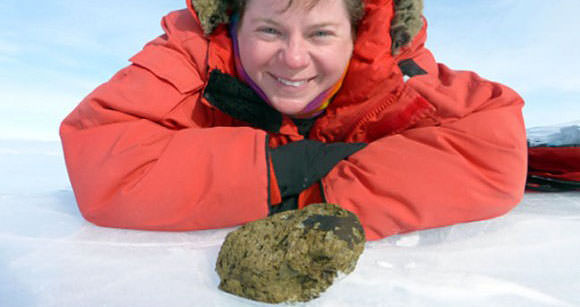
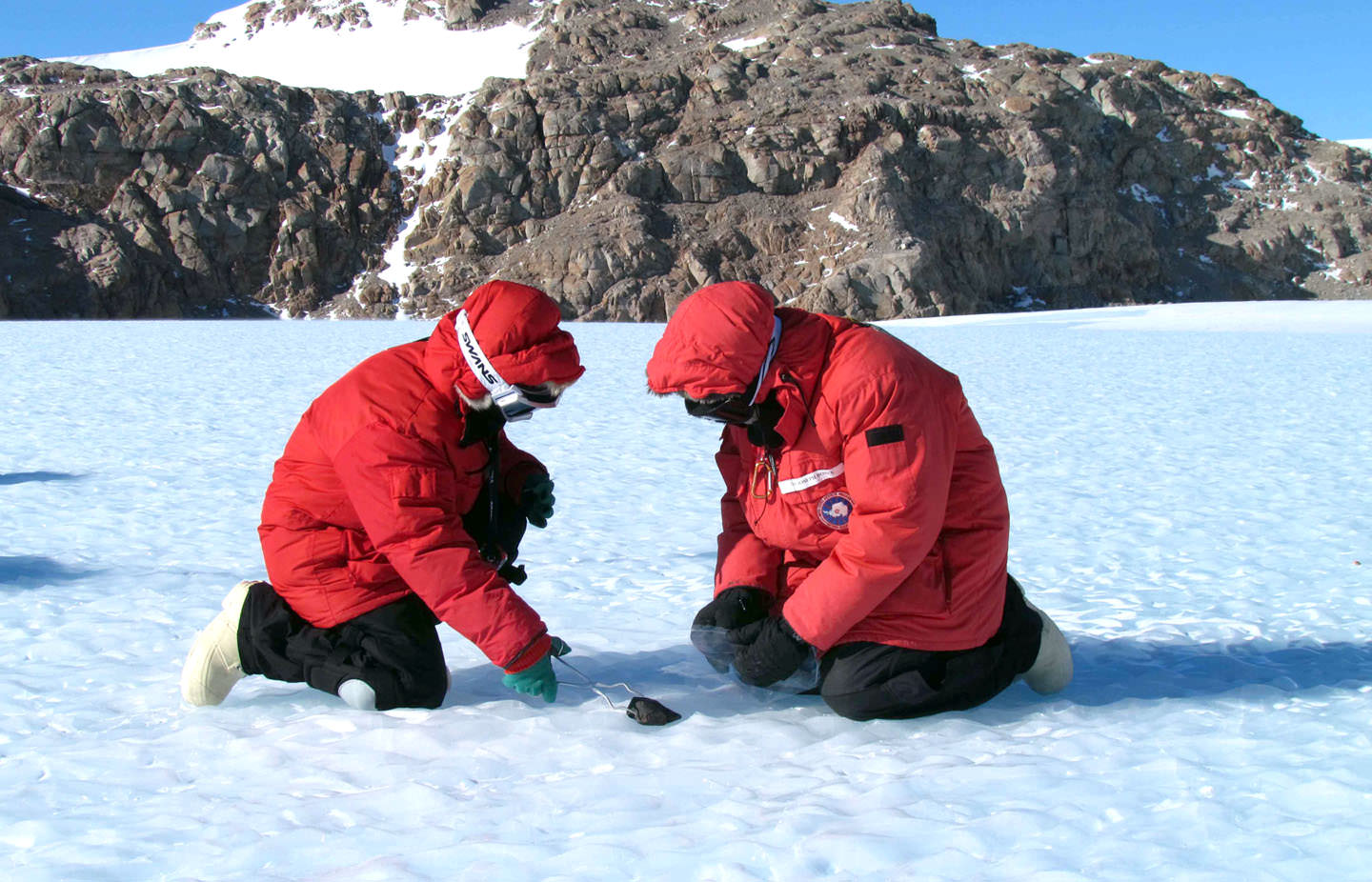
In the category of why-didn’t-I think-of-that ideas, Dr. Geoffrey Evatt and colleagues from the University of Manchester struck upon a brilliant hypothesis: that a layer of iron meteories might lurk just below the surface of the Antarctic ice. He’s the lead author of a recent paper on the topic published in the open-access journal, Nature Communications.
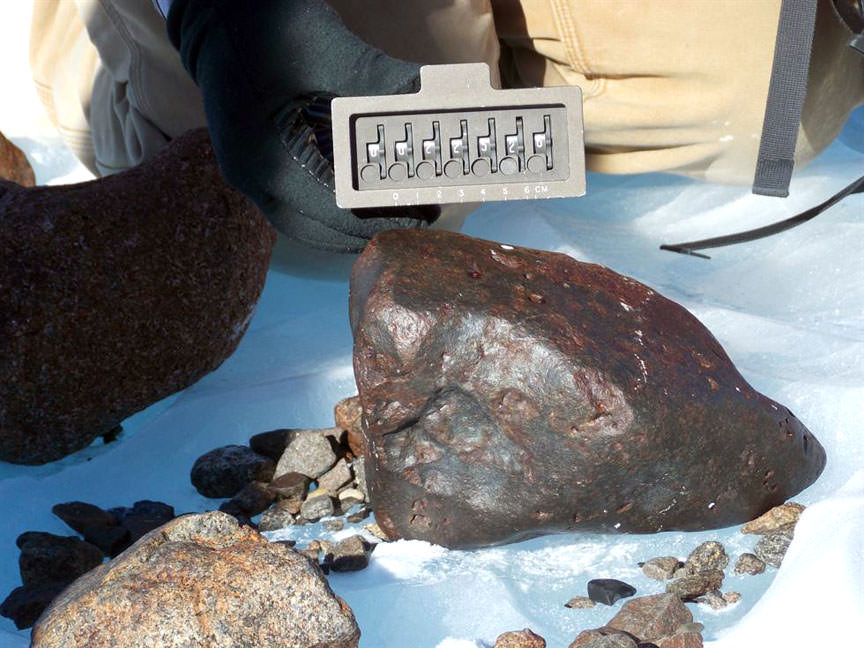
Remote Antarctica makes one of the best meteorite collecting regions on the planet. Space rocks have been accumulating there for millennia preserved in the continent’s cold, desert-like climate. While you might think it’s a long and expensive way to go to hunt for meteorites, it’s still a lot cheaper than a sample return mission to the asteroid belt. Meteorites fall and become embedded in ice sheets within the continent’s interior. As that ice flows outward toward the Antarctic coastlines, it pushes up against the Transantarctic Mountains, where powerful, dry winds ablate away the ice and expose their otherworldly cargo.
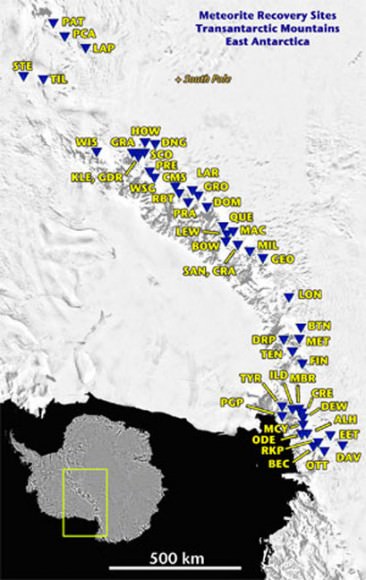
Layer after layer, century after century, the ice gets stripped away, leaving rich “meteorite stranding zones” where hundreds of space rocks can be found within an area the size of a soccer field. Since most meteorites arrive on Earth coated in a black or brown fusion crust from their searing fall through the atmosphere, they contrast well against the white glare of snow and ice. Scientists liken it to a conveyor belt that’s been operating for the past couple million years.
Scientists form snowmobile posses and buzz around the ice fields picking them up like candy eggs on Easter morning. OK, it’s not that easy. There’s much planning and prep followed by days and nights of camping in bitter cold with high winds tearing at your tent. Expeditions take place from October through early January when the Sun never sets.
The U.S. under ANSMET (Antarctic Search for Meteorites, a Case Western Reserve University project funded by NASA), China, Japan and other nations run programs to hunt and collect the precious from the earliest days of the Solar System before they find their way to the ocean or are turned to dust by the very winds that revealed them in the first place. Since systematic collecting began in 1976, some 34,927 meteorites have been recovered from Antarctica as of December 2015.
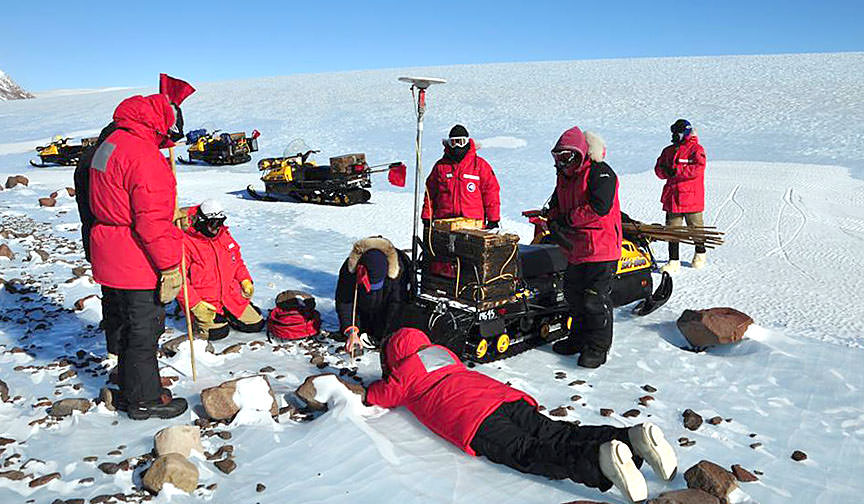
Meteorites come in three basic types: those made primarily of rock; stony-irons comprised of a mixture of iron and rock; and iron-rich. Since collection programs have been underway, Antarctic researchers have uncovered lots of stony meteorites, but meteorites either partly or wholly made of metal are scarce compared to what’s found in other collecting sites around the world, notably the deserts of Africa and Oman. What gives?
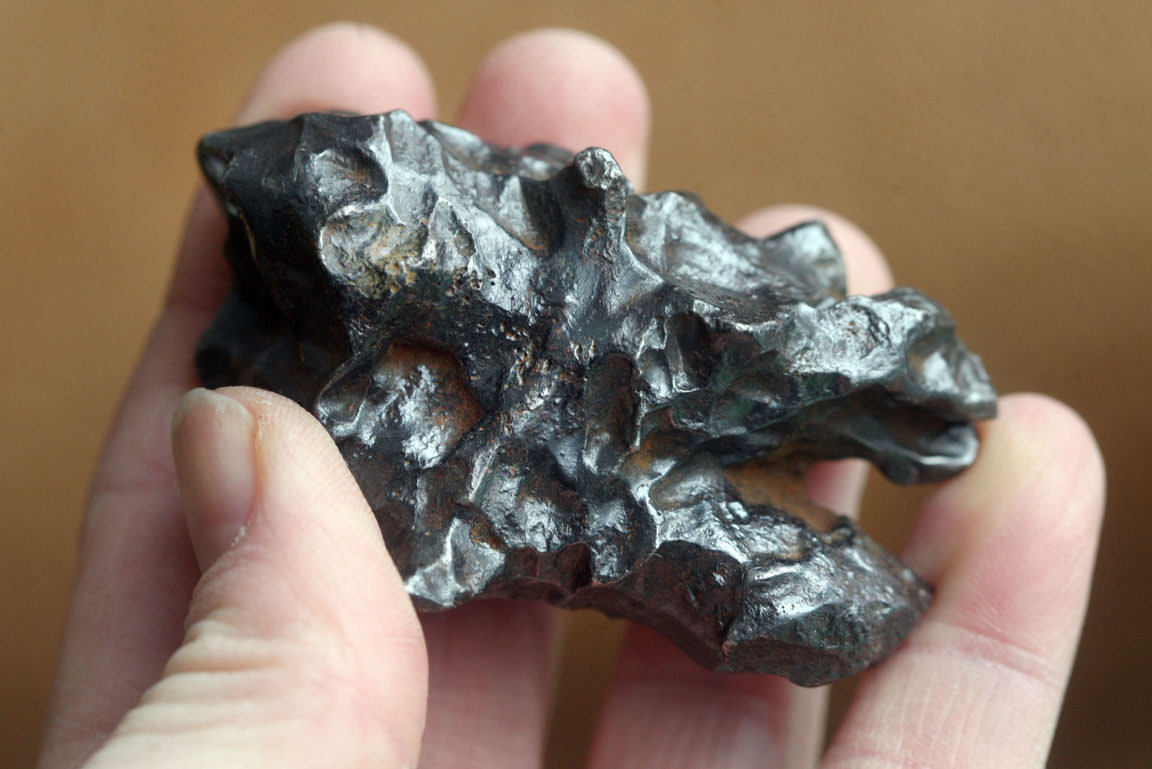
Dr. Evatt and colleagues had a hunch and performed a simple experiment to arrive at their hypothesis. They froze two meteorites of similar size and shape — a specimen of the Russian Sikhote-Alin iron and NWA 869, an ordinary (stony) chondrite — inside blocks of ice and heated them using a solar-simulator lamp. As expected, both meteorites melted their way down through the ice in time, but the iron meteorite sank further and faster. I bet you can guess why. Iron or metal conducts heat more efficiently than rock. Grab a metal camera tripod leg or telescope tube on a bitter cold night and you’ll know exactly what I mean. Metal conducts the heat away from your hand far better and faster than say, a piece of wood or plastic.
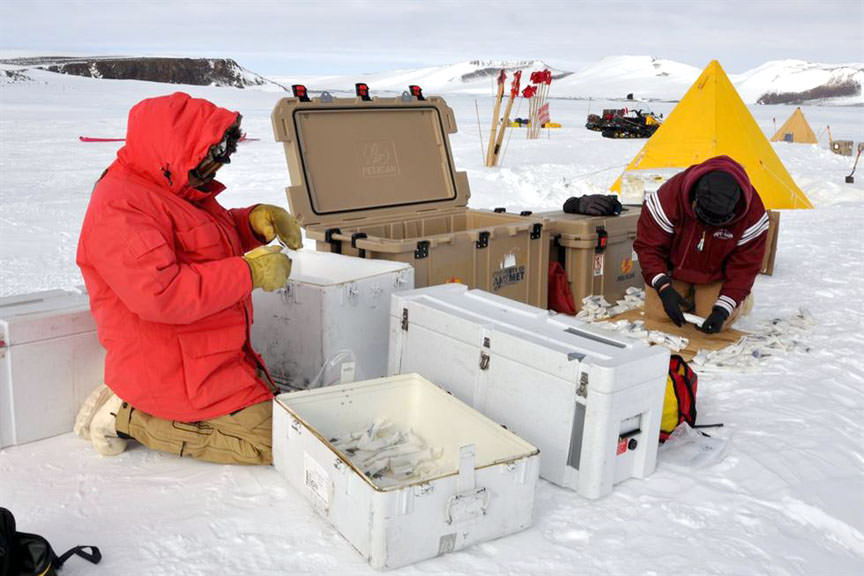
The researchers performed many trials with the same results and created a mathematical model showing that Sun-driven burrowing during the six months of Antarctic summer accounted nicely for the lack of iron meteorites seen in the stranding zones. Co-author Dr. Katherine Joy estimates that the fugitive meteorites are trapped between about 20-40 inches (50-100 cm) beneath the ice.
Who wouldn’t be happy to find this treasure? Dr. Barbara Cohen is seen with a large meteorite from the Antarctic’s Miller Range. Credit: Antarctic Search for Meteorites Program
You can imagine how hard it would be to dig meteorites out of Antarctic ice. It’s work enough to mount an expedition to pick up just what’s on the surface.
With the gauntlet now thrown down, who will take up the challenge? The researchers suggests metal detectors and radar to help locate the hidden irons. Every rock delivered to Earth from outer space represents a tiny piece of a great puzzle astronomers, chemists and geologist have been assembling since 1794 when German physicist Ernst Chladni published a small book asserting that rocks from space really do fall from the sky.
Like the puzzle we leave unfinished on the tabletop, we have a picture, still incomplete, of a Solar System fashioned from the tiniest of dust motes in the crucible of gravity and time.
What About a Mission to Europa?
Europa’s water exists in a layer around the planet, encased in a layer of ice. Could there be life down there?
Hooray! Welcome to the 200th official episode of the Guide To Space!
First off, thank you. Thank you for watching, liking, sharing, subscribing and being a patron of our show. Yes, you. Thank you.
So to celebrate, a few weeks ago we invited the members of the Weekly Space Hangout Crew Google+ Community to suggest topics for episodes, and the winner would receive a precious iron-nickel meteorite. Congratulations Andres Munoz, this meteorite is for you.
This episode, chosen by Andres, is for everyone.
The search for life in the Solar System is about the hunt for water. Wherever we find liquid water on Earth, we find life. I’m talking everywhere. In the most briny, salty pools in Antarctica, in the hottest hot springs in Yellowstone, under glaciers, and kilometers deep underground.
So we go searching for liquid water in the Solar System.
You might be surprised to learn that Jupiter’s moon Europa has the most water in the entire Solar System. If you took all the water on Earth, collected it into a big sphere, it would measure almost 1,400 kilometers across.
Europa’s water would measure nearly 1,800 kilometers.All that water exists in a layer around Europa, encased in a layer of ice. How thick? We don’t know.
Is there life down there? We don’t know.You can say there might be, and it wouldn’t be untrue. However, if you say there isn’t, that’s way less interesting for clickbait purposes. Whenever we don’t know the answers to fundamental and intriguing questions like that, it’s time to send a mission.
Good news! An actual mission to Europa is in the works right now. In 2015, NASA approved the development of an orbiter mission to Europa. If all goes well, and nothing gets cancelled…
And nothing will get cancelled, right? Right? I heard Firefly. Which one of you said Firefly?!?
According to the plan, a spacecraft will launch in the 2020s, carrying 9 instruments to Europa. Most will be familiar cameras, mass spectrometers, and the like, to study the surface of Europa to a high level of resolution. Over the course of 45 flybys, the spacecraft will get down as close as 25 kilometers and capture it with incredible resolution.
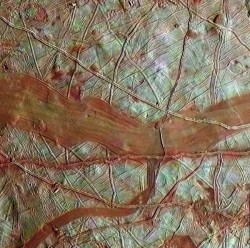
Perhaps the most exciting, and controversial instrument on board the new Europa Orbiter mission will be its ice-penetrating radar. Mission planners battled over installing a radar this sophisticated, as it will be an enormous drain on the orbiter’s power.
This for us is incredibly exciting. It will allow the spacecraft to map out the depth and thickness of Europa’s icy exterior. Is it thick or thin? Are there pockets of water trapped just below the surface, or is it tough shell that goes on for dozens of kilometers?
The worst case scenario is that the shell goes thicker than the radar can reach, and we won’t even know how far it goes.
Whatever happens, the Europa orbiter will be a boon to science, answer outstanding questions about the moon and the chances of finding life there.
We’re just getting started. What we really want to send is a lander. Because of the intense radiation from Jupiter, the Sun, and space itself, the surface of the ice on Europa would be sterilized. But dig down a few centimeters and you might find life that’s protected from the radiation.
A future Europa lander might be equipped with a heated drill attached to a tether. The lander would be have with a heat-generated radioisotope thermoelectric generator, like most of NASA’s big, outer Solar System spacecraft.
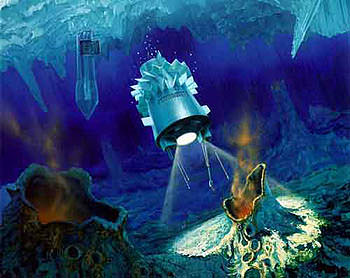
But in addition to using it for electricity, it’ll use the raw heat to help a tethered drill to grind through the ice a few meters and sample what’s down there.
Drilling more than a few meters is probably the stuff of science fiction. Russian scientists in Antarctica drilled for almost two decades to get through 4,000 meters of ice above Lake Vostok. Imagine trying to get through 100 kilometers of the stuff, on a distant world, with a robot.
But, since I’ve talked about moving the Sun, and terraforming the Moon, maybe I shouldn’t put any bounds on my imagination. Nuclear-powered Europa submarines will get us swimming with the singing Europan space whales in no time.
Europa is the best place to search the Solar System for life, and I’m excited to see what the upcoming Europa Orbiter mission turns up. And I’m even more excited about the possibility of any future lander missions.
It was a lot of fun wrapping my brain around a topic chosen by the fans. What topic would you like us to cover next? I’ve got a whole pocket of meteorites here. Put it in the comments below.
First, I want to thank everyone. It’s been a crazy race getting up to 200 episodes, but it’s been a blast all the way through. Thanks again for all your support and here’s to 200 more!
What’s Up With Ceres’ Mysterious Bright Spots? Reply Hazy, Ask Again Later
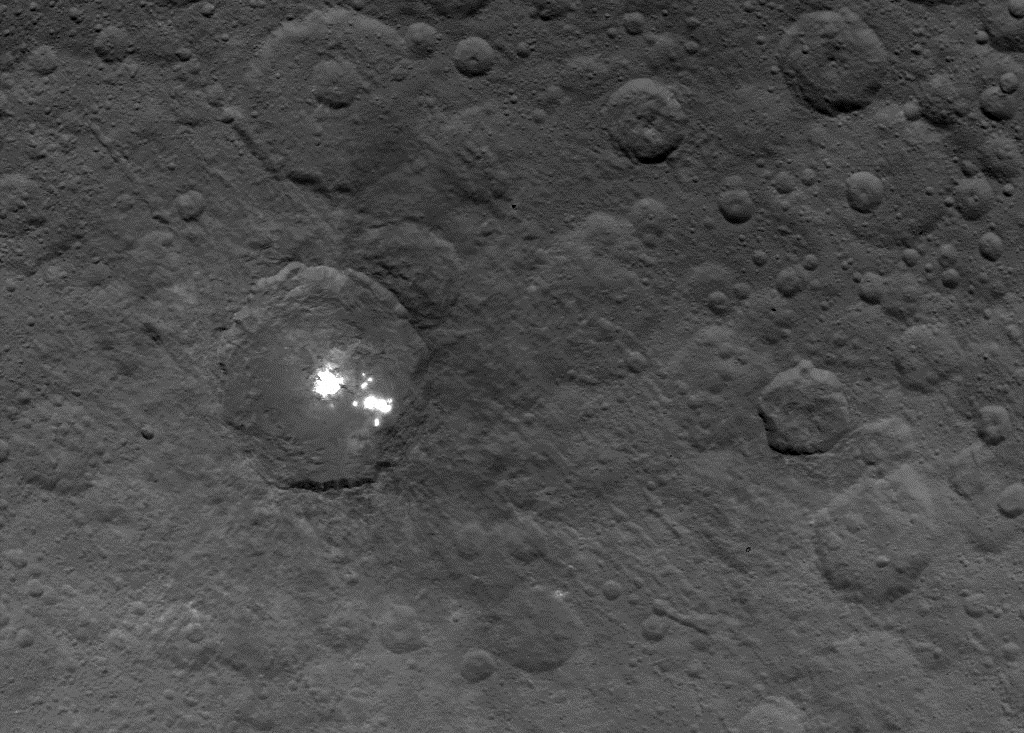
The crater that contains those puzzlingly bright spots on Ceres may harbor an equally puzzling haze. Or not. The hints of haze on the dwarf planet, seen in some of the images coming from NASA’s Dawn spacecraft, add another intriguing twist to Ceres’ mysteries.
The hubbub over haze arose this week during the Exploration Science Forum at NASA’s Ames Research Center in California. For months, Dawn’s scientists have been observing – and trying to make sense out of – unusually reflective spots within Ceres’ craters that show up when the asteroid turns into the sunlight. The team has speculated that they could be frozen pools of water ice, or patches of light-colored, salt-rich material.
The brightest spots are known collectively as Spot 5, and sit inside Occator Crater on Ceres. Dawn’s principal investigator, Chris Russell of the University of California at Los Angeles, told the forum that some type of haze could be seen inside the crater at certain times of Ceres’ day, according to reports from Nature and the Planetary Society. Nature quoted Russell as saying the bright spots “could be providing some atmosphere in this particular region of Ceres.”
Last year, scientists with the European Space Agency’s Herschel mission reported detecting signs of water vapor rising from Ceres’ surface, and it would be tempting to suggest that the water vapor is emanating from bright icy spots and creating the haze. That would strengthen Ceres’ status as the only asteroid with a significant atmosphere and a subsurface reservoir of water, and stoke speculation about life on Ceres.
However, Russell told Universe Today that it’s way too early to give in to temptation.
“I was speaking from less than a handful of images, and the interpretation of the images is disputed by some team members,” Russell said in an email. “I would like the debate to go on internally before we make a pronouncement one way or the other. I of course have my personal opinion, but I am not always right.”
"Whateer the cause of the bright spots, Ceres is active today". #nasaames #ceres #sservi pic.twitter.com/y718IDloda
— Sidney N. Nakahodo (@snnaka) July 21, 2015
Russell said the ice-vs.-salt debate is continuing. “I originally was an advocate of ice, because of how bright the spots seemed to be,” he said. However, the bright material’s albedo, or reflectivity factor, is about 50 percent – which is less than Russell originally thought. “This could be salt and is unlikely to be ice. I think the team opinion is now more in line with salt,” he said.
Either way, Russell doesn’t see any way for the spots to form without internal activity on Ceres. “Thus, the very existence of the spots tells us that there is some active process going on,” he told Universe Today.
Will we ever know if the haze is for real? Or what the spots are made of? As the Magic 8-Ball might say, “Ask again later.” The Dawn spacecraft recently recovered from a mechanical glitch and is gradually descending to a closer mapping orbit, around an altitude of 900 miles (1,500 kilometers). That will provide a much better look at Occator Crater and what lies within.
“Eventually I am expecting the spectral data will unambiguously tell us what has happened to the surface,” Russell said, “but it is a little too soon to be sure.”

